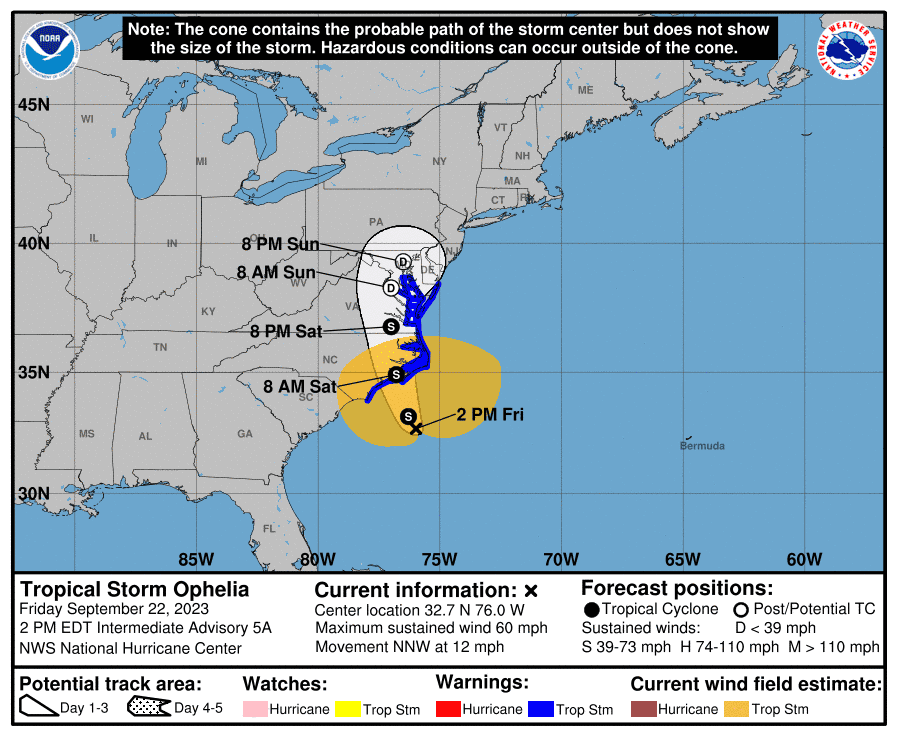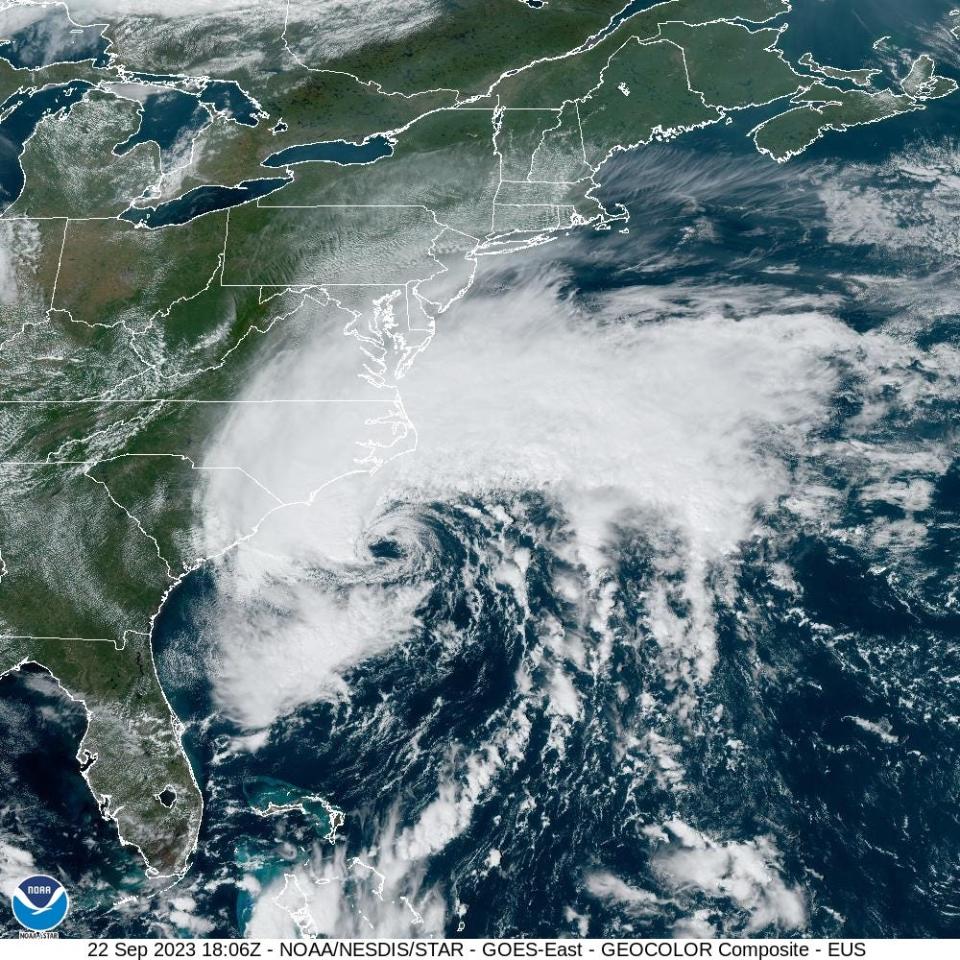Hurricane watch issued in North Carolina as Tropical Storm Ophelia strengthens
Tropical Storm Ophelia strengthened to near-hurricane status just off the Southeast coast Friday afternoon, a storm that promises to deliver a messy mix of heavy rain, strong winds, storm surge and even possible tornadoes to much of the East Coast over the weekend.
A hurricane watch was issued for portions of eastern North Carolina, from north of Surf City to Ocracoke Inlet as the storm's winds have increased to 70 mph, just 4 mph from hurricane strength.
"People in coastal areas should take this storm seriously," AccuWeather meteorologist Bernie Rayno said. "This is going to be a nasty and formidable storm."
The governors of North Carolina and Virginia declared a state of emergency Friday. Some schools closed early as communities prepared for the storm’s arrival, and several weekend events were canceled.
Tropical storm conditions already underway
Tropical storm conditions began Friday along portions of the East Coast.
According to the National Hurricane Center, there is a danger of life-threatening storm surge, high surf and rip currents, along with heavy rainfall across the Mid-Atlantic, from North Carolina to New Jersey.
Ophelia is likely to bring several inches of rain, the center said, impacting outdoor events and NFL games.
Where is Tropical Storm Ophelia? When will it make landfall?
At 2 a.m. ET Saturday, the hurricane center said the center of Ophelia was about 55 miles south-southwest of Cape Lookout, North Carolina, with maximum sustained winds of 70 mph. The storm was moving north-northwest at 12 mph. More than 7 million people were under tropical storm warnings on Friday afternoon.
Landfall is expected in North Carolina Saturday morning, the hurricane center said.
Big waves were being reported off the North Carolina coast, with significant wave heights – meaning the average of the top third of the waves – ranging from 15 to 19 feet within 2-26 miles offshore. A U.S. Navy buoy in the Chesapeake channel reported significant wave heights of 7.5 feet around 1 a.m. ET.

NHC warns of 'life-threatening' storm surge, rip currents
Dangerous rip currents and storm surge are expected along stretches of North Carolina and Virginia, the hurricane center said.
"Life threatening" storm surge is possible along coastal areas and inland rivers. The hurricane center warned of potential storm surge inundation of 4-6 feet in some areas.
Heavy rainfall could complicate matters. Ophelia is forecast to produce 3-5 inches of rainfall, with localized amounts of up to 7 inches across eastern North Carolina and southeastern Virginia, with 2-4 inches through the mid-Atlantic and 1-3 inches across southern New York through southern New England into Monday.
"Persons located within these areas should take all necessary actions to protect life and property from rising water and the potential for other dangerous conditions," the hurricane center said. "Promptly follow evacuation and other instructions from local officials."
Storm warning: Tropical Storm Ophelia heads for the East Coast after a surprising, confusing start.
A 'myriad of hazards'
Some of the worst impacts from the storm will be in eastern portions of Virginia, Maryland and North Carolina. The Wakefield, Virginia, National Weather Service office published an ominous local forecast for potentially "dangerous conditions" throughout much of the region, including Central and Eastern Virginia, the lower Maryland eastern shore and northeastern North Carolina.
Regardless of the storm’s track, “it’s expected to bring a myriad of hazards,” the weather service said.
That includes the following potential impacts:
Dangerous high surf and seas – The worst marine conditions are expected over Saturday and into Sunday, with large nearshore breaking waves of 6-10 feet that will result in beach erosion and a high risk of rip currents.
Storm surge and coastal flooding – Severe storm surge with possible significant impacts across Eastern Virginia and northeast North Carolina, extending inland from the waterfront and shoreline, flooding homes and isolating neighborhoods. Moderate to major coastal flooding during high tides Friday night and into Saturday.
Heavy rainfall - Flooding may prompt evacuations and rescues, with rivers and tributaries quickly become swollen with swift currents.
Winds – Tropical storm force winds could down trees and power lines, and a dangerous tornado event is possible.
Track Tropical Storm Ophelia
This forecast tracker shows the most likely path of the center of the storm. It does not illustrate the full width of the storm or its impacts, and the center of the storm is likely to travel outside the cone up to 33% of the time.
State of emergency declared in Virginia and North Carolina
Virginia Gov. Glenn Youngkin declared a state of emergency Friday afternoon, issuing an executive order intended to ease response and recovery efforts.
“As this storm has organized and strengthened, it’s becoming clear based on the latest forecasts that impacts to the commonwealth are likely,” Youngkin said in a statement. “We want to ensure that all communities, particularly those with the greatest anticipated impact, have the resources they need to respond and recover from the effects of this storm.”
The governor encouraged residents to prepare an emergency kit and follow the weather forecast closely.
In North Carolina, Gov. Roy Cooper issued an emergency declaration aiming to expedite preparations and help provide a swift response to the storm.
“The storm’s path has been difficult to predict and we want to ensure that farmers, first responders and utility crews have the tools necessary to prepare for severe weather,” Cooper said.
What's the difference between a tropical cyclone and a tropical storm?
In the Atlantic Ocean, tropical depressions, tropical storms and hurricanes are all types of tropical cyclones.
That's because "tropical cyclone" is a generic term for the low pressure systems that form over warm tropical seas with a warm core, closed center of circulation and organized thunderstorm activity.
Here's how different types of tropical cyclones are defined:
Tropical depression: maximum sustained surface winds of 38 mph
Tropical storm: sustained surface winds of 39 mph to 73 mph. At this intensity, a storm is named.
Hurricane: A tropical storm that has reached maximum sustained winds of 74 mph.

Ophelia is the 16th named storm of the season
Ophelia is the 16th named storm of the 2023 Atlantic hurricane season, according to Colorado State University hurricane researcher Phil Klotzbach.
Another system in the Atlantic, west of the Cape Verde islands, has a 90% chance of becoming a tropical storm over the next five days as it moves west-northwestward.
Contributing: Kimberly Miller, Palm Beach Post; Pacific Daily News; The Associated Press.
This article originally appeared on USA TODAY: Hurricane watch issued in North Carolina due to Ophelia

